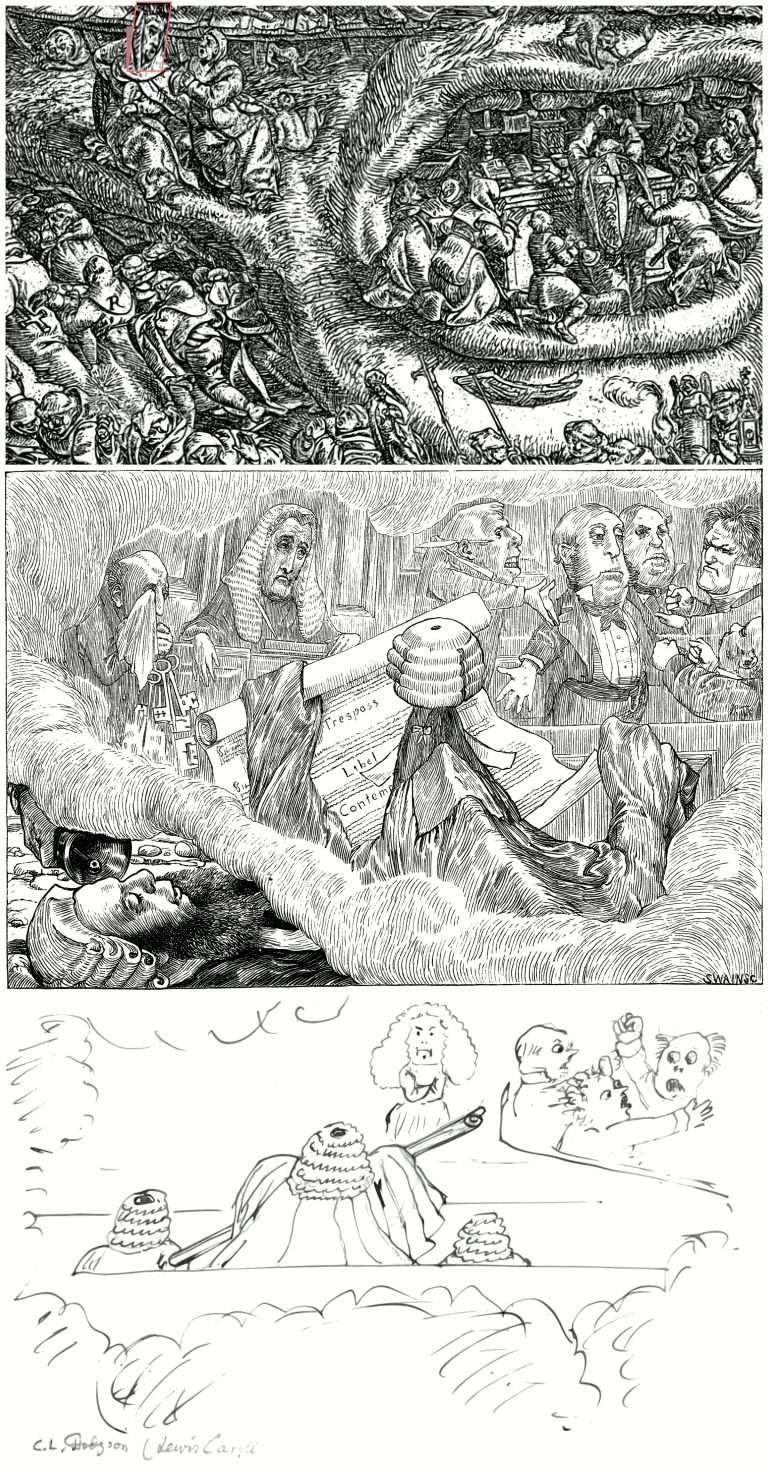2021-05-02, updated: 2021-06-05
Category: artists
Alice on the Train
Bycatch (but not mine):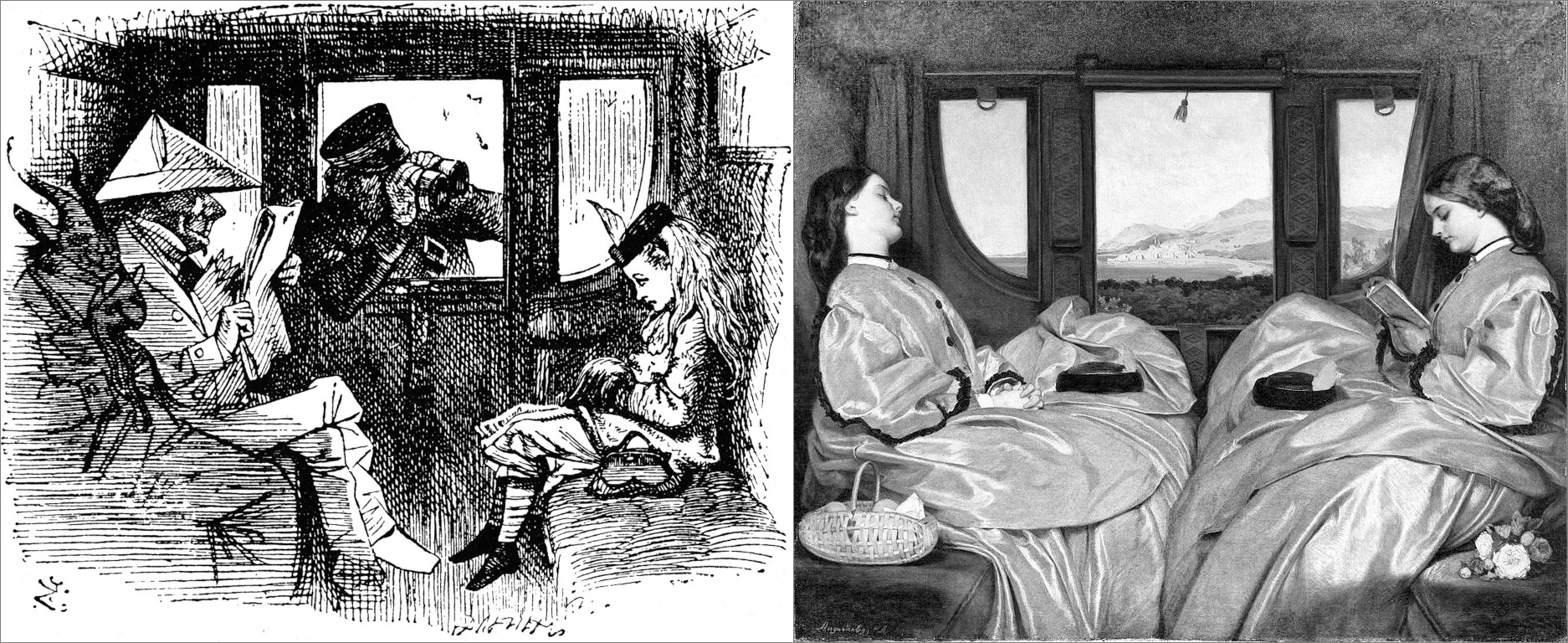
[left]: John Tenniel: Alice on the Train (1872)
[right]: Augustus Leopold Egg: The Travelling Companions (1862)
I found the comparison in preraphaelitesisterhood.com. If it is a pictorial reference at all, it might be a nice pun by Tenniel, but not as challenging as Henry Holiday’s conundrums.
Playing with the work of other artists could have been fun for John Tenniel too. (Of course another reason for such similarities always could be, that Holiday and Egg both referred an image by a third artist.)
2017-09-22, updated: 2021-05-24
Big Head in a Mess
Alice in the Woods
Bycatch from my Snark hunt:
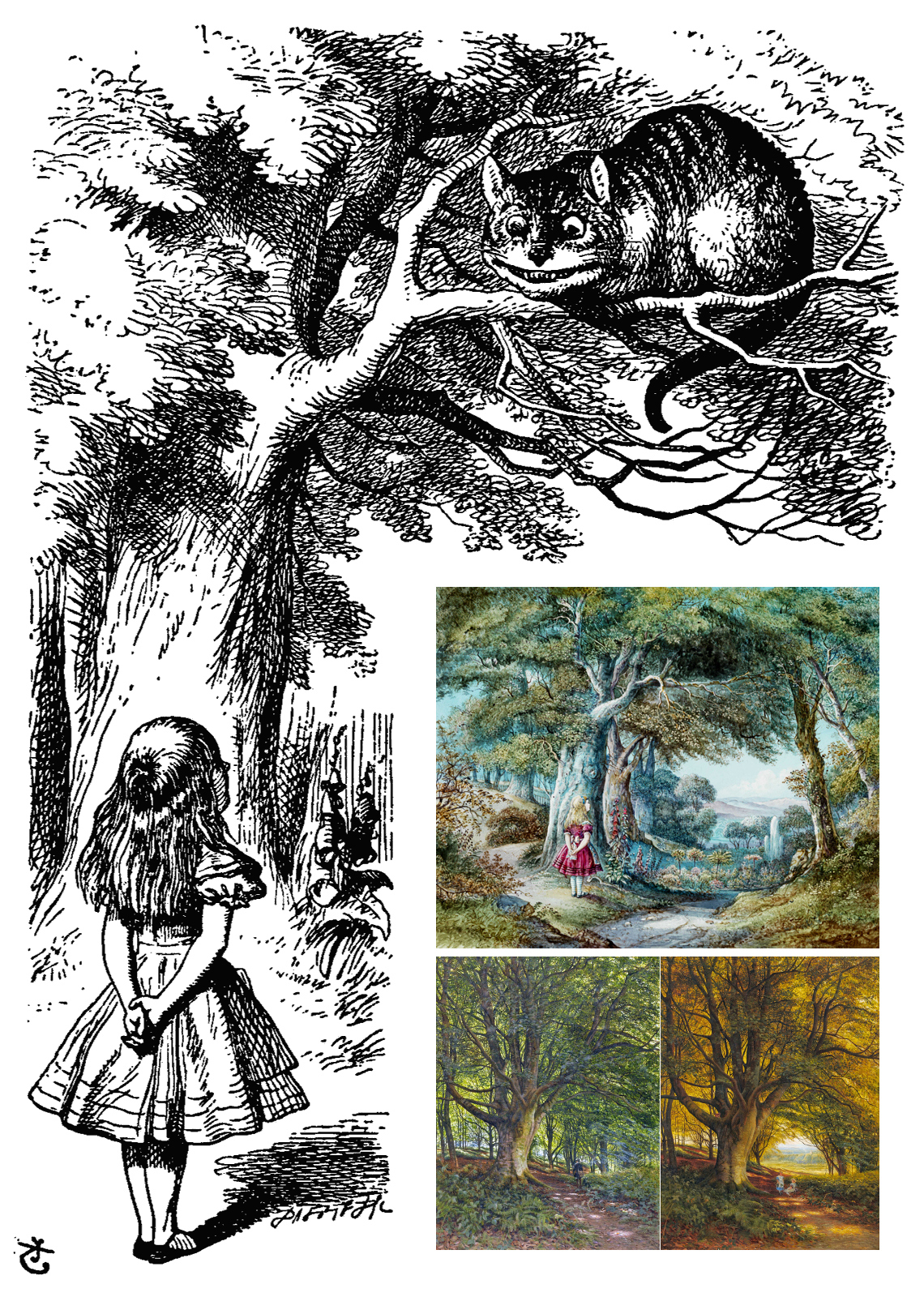
- [background]: Sir John Tenniel: Alice & Cheshire Cat (1866 or 1869?)
vintageephemera.blogspot.de/2010/08/book-illustration-cheshire-cat-alices.html - [center right]: Magic lantern slide by William Robert Hill: Alice in Wonderland (1876)
twitter.com/Bonnetmaker/status/525660964700848129 - [bottom center]: Bonomi Edward Warren: Sportsman and dog on a wooded path (1868, watercolor)
- [bottom right]: Bonomi Edward Warren: Woodland Scene in Summer with Children on a Path (1871, oil on canvas)
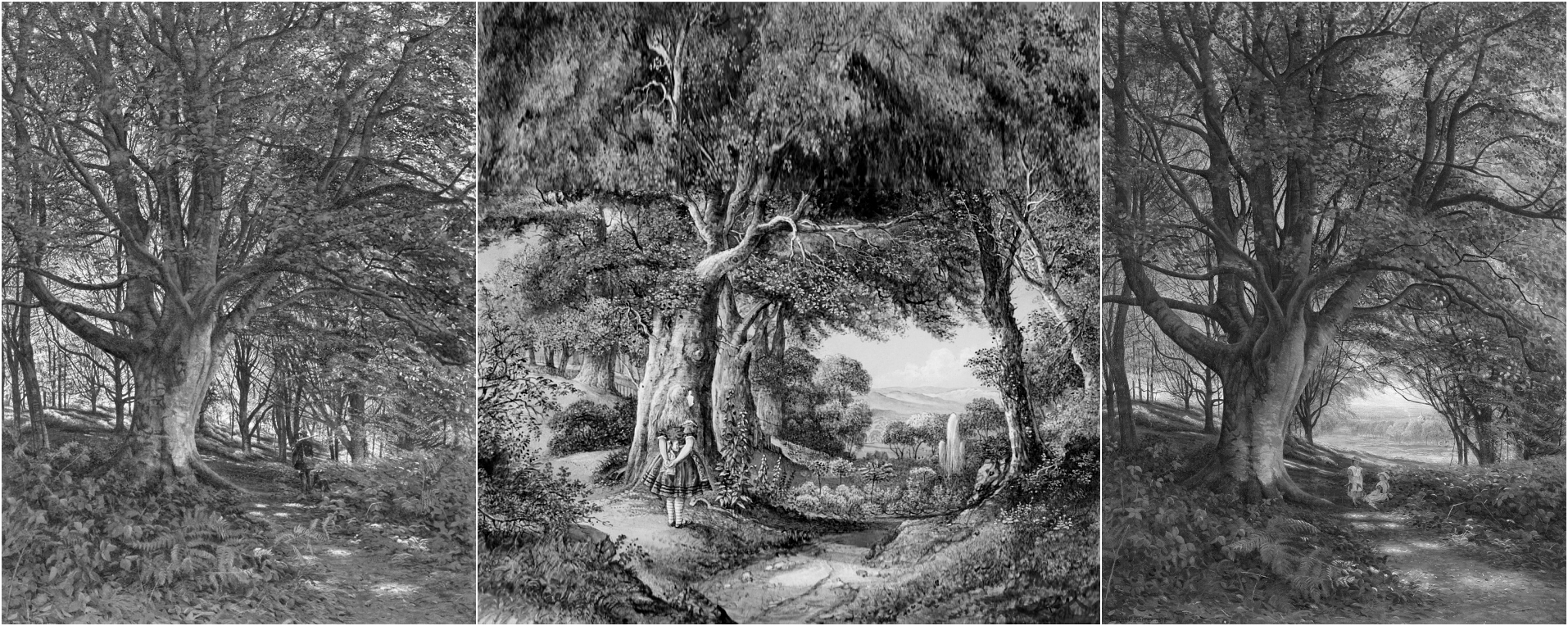
2018-03-31, updated: 2021-03-31
Monstrous Things from Walls
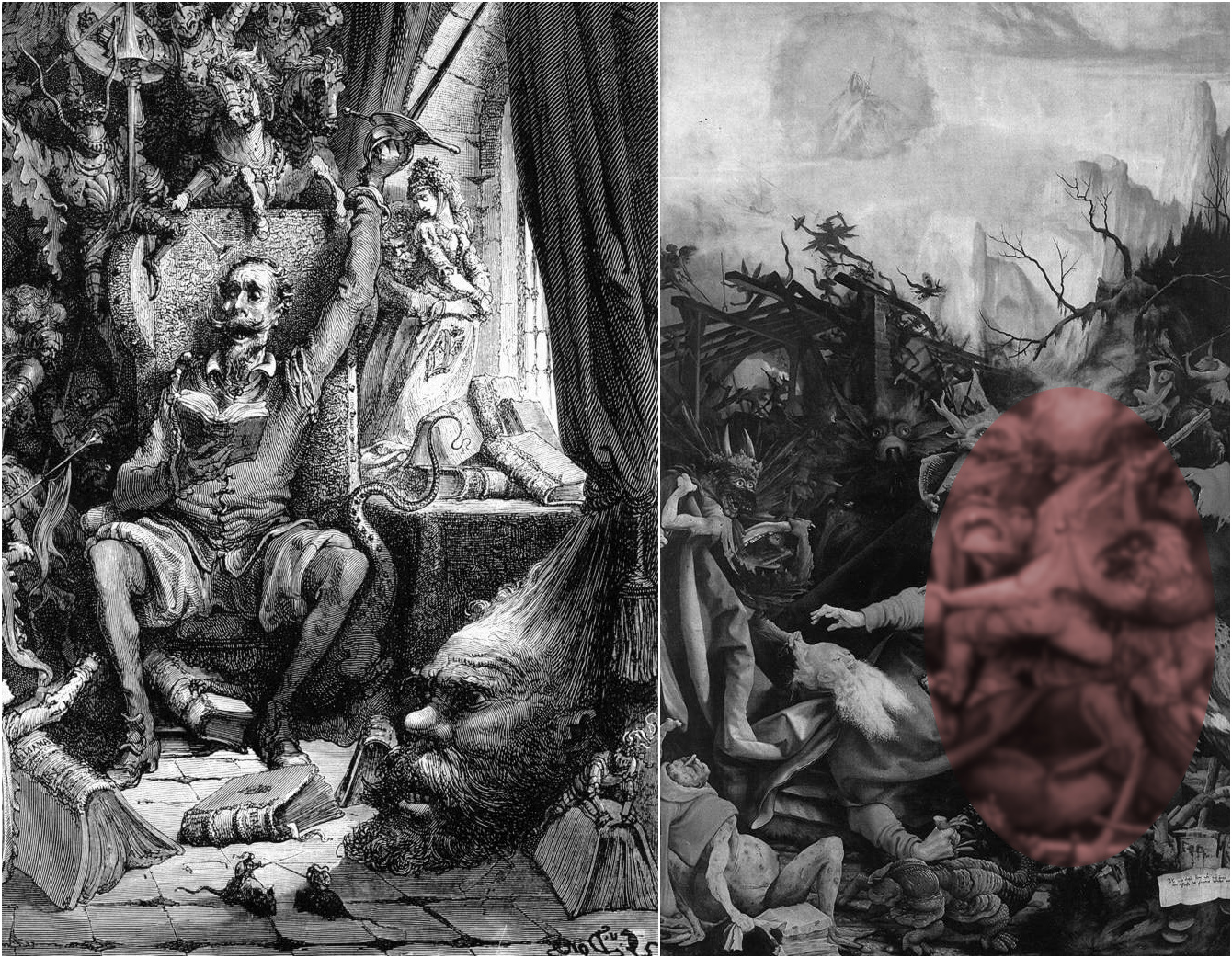 The monsters already were there. But what did Gustave Doré see in the sky in Matthias Grünewald’s painting?
The monsters already were there. But what did Gustave Doré see in the sky in Matthias Grünewald’s painting?
Look at walls splashed with a number of stains, or stones of various mixed colours. If you have to invent some scene, you can see there resemblances to a number of landscapes, adorned with mountains, rivers, rocks, trees, great plains, valleys and hills, in various ways. Also you can see various battles, and lively postures of strange figures, expressions on faces, costumes and an infinite number of things, which you can reduce to good integrated form. This happens on such walls and varicoloured stones, (which act) like the sound of bells, in whose peeling you can find every name and word that you can imagine.
Do not despise my opinion, when I remind you that it should not be hard for you to stop sometimes and look into the stains of walls, or the ashes of a fire, or clouds, or mud or like places, in which, if you consider them well, you may find really marvelous ideas. The mind of the painter is stimulated to new discoveries, the composition of battles of animals and men, various compositions of landscapes and monstrous things, such as devils and similar things, which may bring you honor, because by indistinct things the mind is stimulated to new inventions.
Reprinted from the Oxford edition of Selections from the Notebooks of Leonardo da Vinci, edited by Irma A. Richter. The selections are from da Vinci’s A Treatise on Painting (Trattato della pittura).
(Thanks to Jono Borden for asking.)
2017-12-29, updated: 2022-03-10
Holiday’s Butcher and Millais’ Raleigh
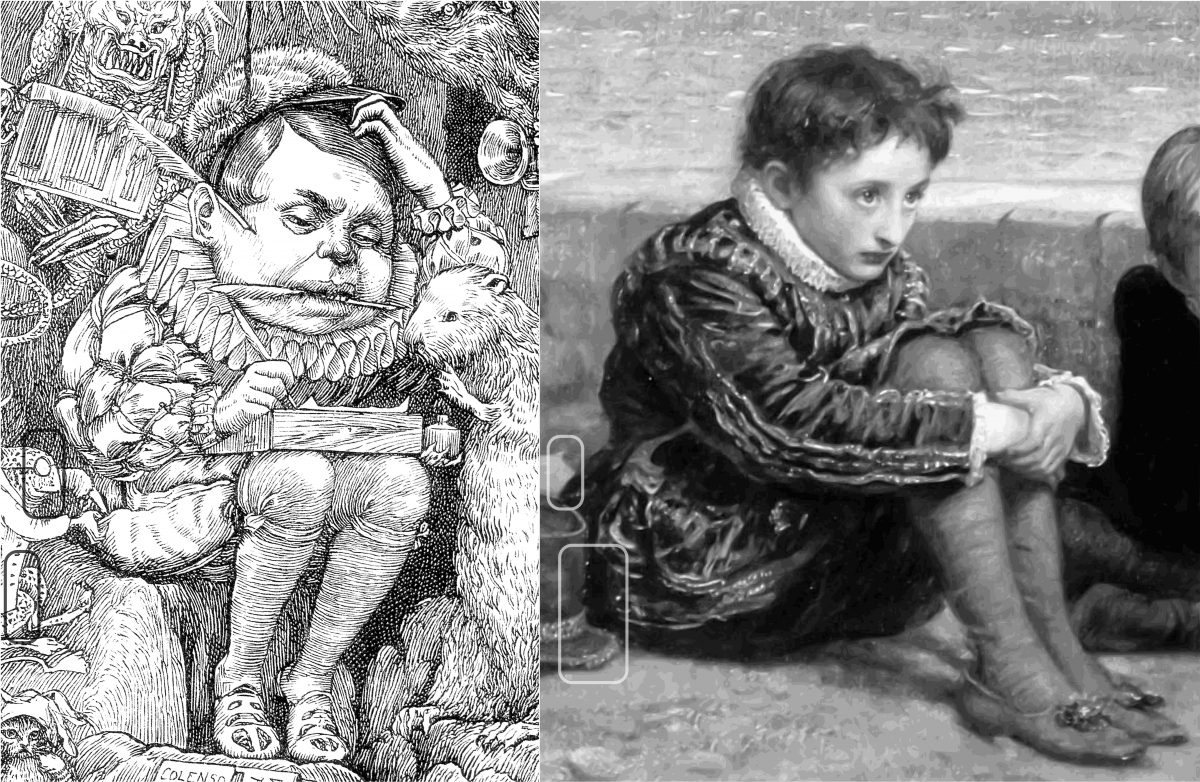
But perhaps Holiday’s ruff – and the pose of the Fit Five drawing – was inspired by the Elizabethan drama inherent in Millais’ Boyhood of Raleigh, (1869).
Louise Schweitzer, One Wild Flower (2012)
If you want to be on the safe side, just claim that the meaning of the Snark is elusive. But to the more courageous readers I recommend Louise Schweitzer’s doctoral thesis One Wild Flower.
2017-09-04, update: 2021-03-05
“Thought to be based on Gheeraert’s iconoclasm image”
Message to the Public Domain Review (2019-10-10): You are using my comparison (from December 2008) without proper referencing. This was my first discovery of one of Henry Holiday’s allusions. This finding started my Snark hunt. I think that Public Domain Review should specify the source (my proposal).
(February 2021: Now there is a link “thought by some” in publicdomainreview.org/collection/the-art-of-hidden-faces-anthropomorphic-landscapes)
Image (2019-10-10) from 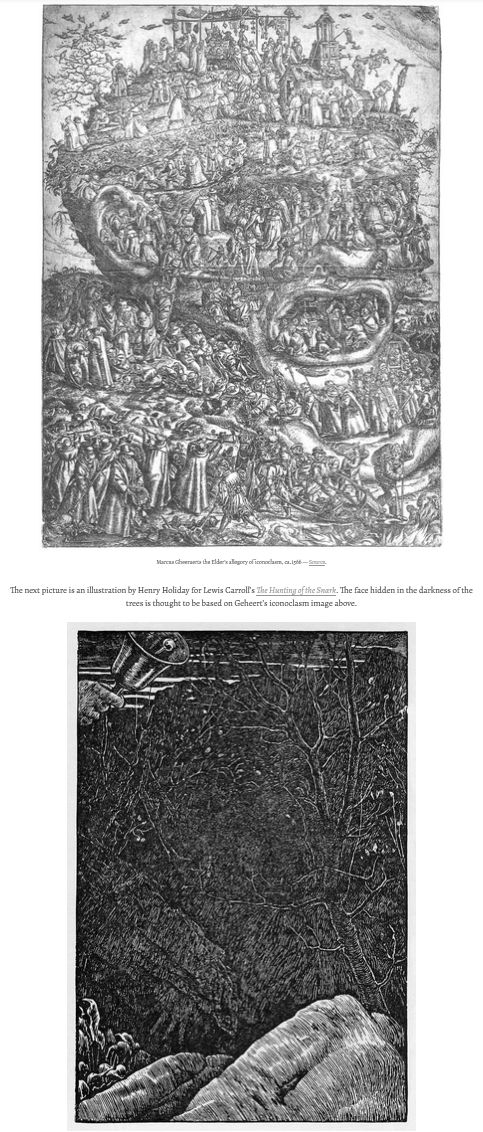 https://publicdomainreview.org/collection/the-art-of-hidden-faces-anthropomorphic-landscapes#17-0:
https://publicdomainreview.org/collection/the-art-of-hidden-faces-anthropomorphic-landscapes#17-0:
Marcus Gheeraerts the Elder’s allegory of iconoclasm, ca.1566 — Source.
The next picture is an illustration by Henry Holiday for Lewis Carroll’s The Hunting of the Snark. The face hidden in the darkness of the trees is thought to be based on Geheert’s iconoclasm image above.
The tenth of Henry Holiday’s original illustrations to Lewis Carroll’s The Hunting of the Snark, 1876 — Source.
By the way, it’s not “the 10th” of Henry Holiday’s original illustrations to Lewis Carroll’s The Hunting of the Snark. Holiday contributed only nine (not ten) illustrations to The Hunting of the Snark and two illustrations for the book cover. The Ocean Chart probably had been made by a typesetter, not by Henry Holiday.
And there are various way’s to write Gheeraert’s name. 😉
For discussion: Twitter | Flickr 2009
2019-10-10, updated: 2021-02-18
The Face at Musée Unterlinden
2020-12-19: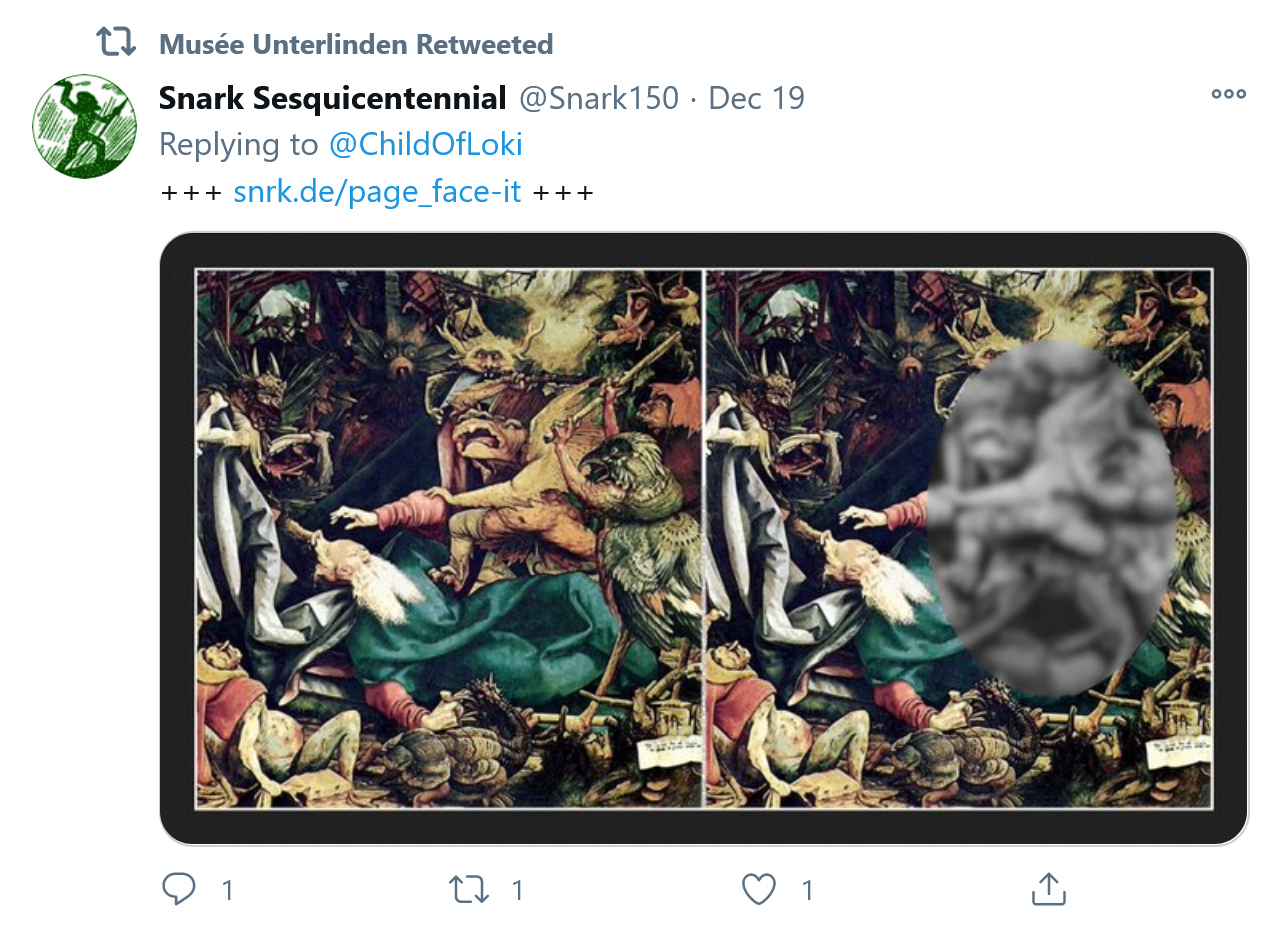
Monstrous Heads | Face it! | Tweets
Happy Holidays!
Inspiration by Re-Interpretation
Lorenzo and Isabella
Bycatch from my Snark hunt:
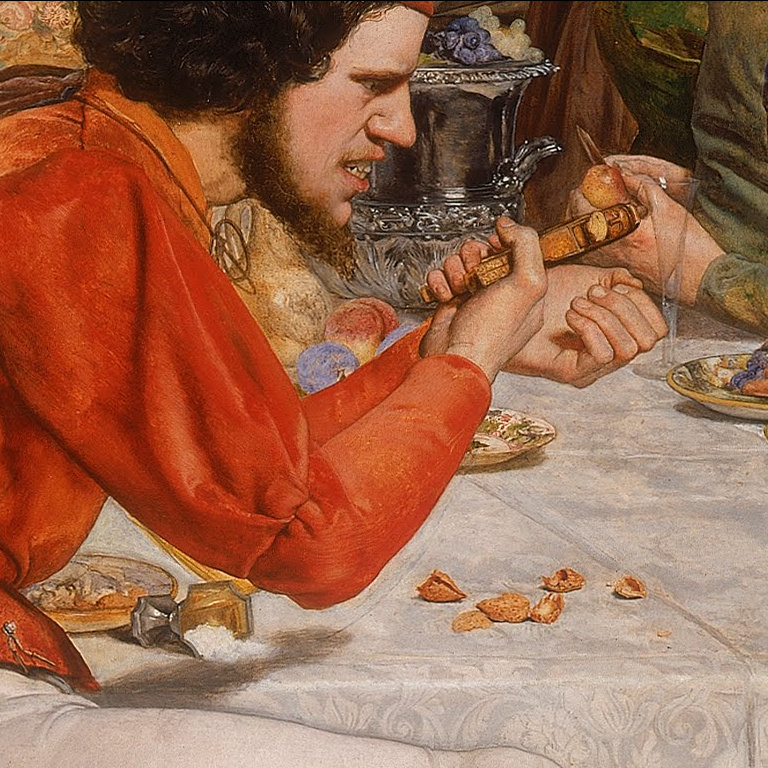
The, well, ambiguity of that “shadow”is known. Also there were some Freudian assumptions regarding what the salt could stand for. But so far I didn’t find any remarks on the impossibility of having a shadow being covered by white salt which isn’t covered by that shadow. To someone who learned physics that is a quite obvious question.
2017-12-17, update: 2020-04-11
Details are Important
When the Queen met the Boojum
This is the first page published in snrk.de, a blog which was set up in 2017. It’s mostly about Lewis Carroll‘s, Henry Holiday‘s and Joseph Swain‘s illustrations to The Hunting of the Snark.
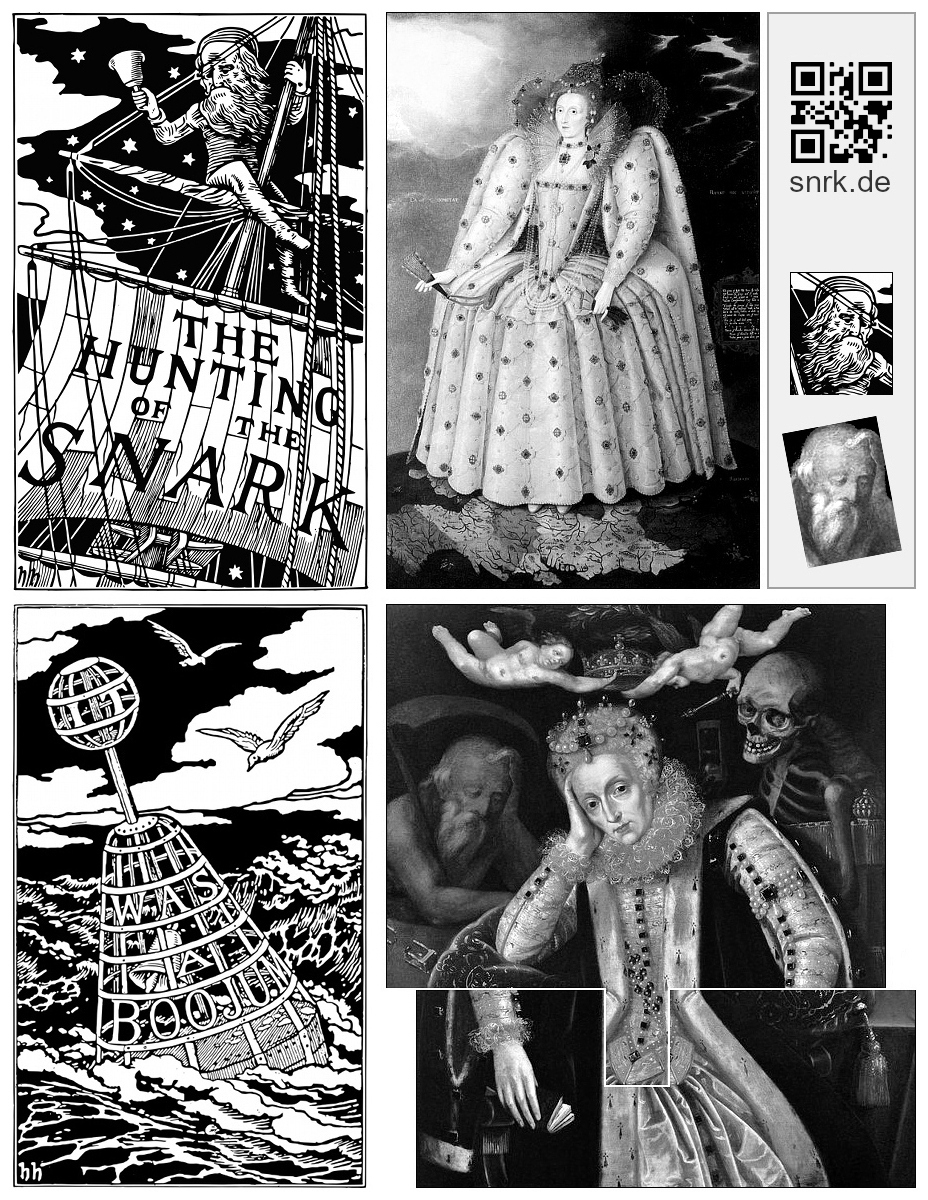
In his Illuminated Snark, John Tufail assumed that the night sky in the front cover of The Hunting of the Snark could be a map. Together with my assumption that Henry Holiday drew inspiration from several paintings by Marcus Gheeraerts (I+II), John’s paper helped me to find the Ditchley Portrait. That again helped me to find the painting by an unknown artist depicting Elizabeth I at old age.
2017-08-28, update: 2020-02-27
“Edward VI and the Pope” on Twitter
EDWARD VI 1537-1553 was the long-awaited heir of King Henry VIII, the object of his father’s life long policy, to secure the Tudor dynasty.
His religious education was in the hands of Thomas Cranmer.
One result was Edward’s complete & thorough conversion to Protestant Reform. pic.twitter.com/z3NAidGbpq
— SPIRITUAL LIVES (@ken_kalis) December 21, 2019
2019-12-21
Thomas Cranmer, compiler of the first Book of Common Prayer, was burned at the stake #OnThisDay 1556 https://t.co/TnjHqhQEf0
— In Our Time (@BBCInOurTime) March 21, 2019
01
The Revd. C.L. Dodgson under his pen name "Lewis Carroll" wrote "The Hunting of the Snark". It also is about Thomas Cranmer. The illustrator Henry Holiday gave us quite clear hints: https://t.co/nSx3ValV65
cc: @monarchomach
— Goetz Kluge (@Bonnetmaker) March 23, 2019
02
About references from "The Hunting of the Snark" to Thomas Cranmer:
※ Angus MacIntyre (1994),
※ Goetz Kluge (2015 https://t.co/zMvRzqMjvO, 2018 https://t.co/BFTGACMfFA, @Bonnetmaker)
※ Mary Hammond (2017, @Hg4words)
※ Karen Gardiner (2018, @KarenGardiner19) pic.twitter.com/eAaCXDhmt0— Goetz Kluge (@Bonnetmaker) March 17, 2019
03 (comment to 02)
"Edward VI and the Pope: An Allegory of the Reformation." (NPG London)
In this 16th century anti-papal propaganda painting Henry VIII is on the left side. Thomas Cranmer is 2nd from left in the upper row on the right side.
More: https://t.co/h24cchf4YTpic.twitter.com/Dsn8MEdj9u
— Goetz Kluge (@Bonnetmaker) March 23, 2019
04
In one of his illustrations (https://t.co/4vu78zj7Jr) to Lewis Carroll's "The Hunting of the Snark", Henry Holiday alluded to the painting "Edward VI and the Pope".
More: https://t.co/hcIThF1al1 pic.twitter.com/INhRxoDly9
— Goetz Kluge (@Bonnetmaker) March 23, 2019
05
I think that also in another illustration (https://t.co/8RYeUCHtTn) to "The Hunting of the Snark" with a depiction of the Baker's 42 boxes (Cranmer's 42 Articles?), Holiday alluded to the depiction of iconoclasm in "Edward and the Pope".
More: https://t.co/eTIRJW9Moa pic.twitter.com/hTJnmslkvC
— Goetz Kluge (@Bonnetmaker) March 23, 2019
06
Margaret Aston wrote a wonderful book on the painting too. The King and the bedpost
— Justin Champion (@monarchomach) March 23, 2019
07
I read that book. It's a marvel. I tried to contact Margaret Aston, but I was too late. https://t.co/3FJuRjYPlZ pic.twitter.com/pMiuRgXMPv
— Goetz Kluge (@Bonnetmaker) March 23, 2019
08
— Goetz Kluge (@Bonnetmaker) March 23, 2019
09
And the Bedpost ended up in "The Hunting of the Snark" as well. I think that Henry Holiday alluded not only to the "Edward VI and the Pope" painting but also to the painting to which "Edward VI and the Pope" alluded.
There perhaps is an chain of allusions. https://t.co/f7SReLHeXJ pic.twitter.com/fz0esGdShS— Goetz Kluge (@Bonnetmaker) March 23, 2019
10
Correction: … the print to which "Edward VI and the Pope" alluded …
— Goetz Kluge (@Bonnetmaker) March 24, 2019
11
https://t.co/f7SReLHeXJ pic.twitter.com/nS2SlS86Dc
— Goetz Kluge (@Bonnetmaker) March 23, 2019
12 (2019-03-23)
The Tax Collector
Retweeted Again
Where Gardner went too far
In the introduction to The Hunting of the Snark (Penguin Classics edition, 1962, 1974,p. 17), Martin Gardner wrote:
How well the academician Holiday succeeded in producing grotesques for the Snark (it is the only work of Carroll’s that he illustrated) is open to debate. Ruskin was certainly right in thinking him inferior to Tenniel. His drawings are, of course, thoroughly realistic except for the overzize heads and the slightly surrealist quality that derives less from the artist’s imagination than from the fact that he was illustrating a surrealist poem.
I think that Gardner certainly was wrong. And Ruskin certainly was wrong as well. But, of course, that is open to debate.
The Barrister’s Dream
The Broker and the Monk
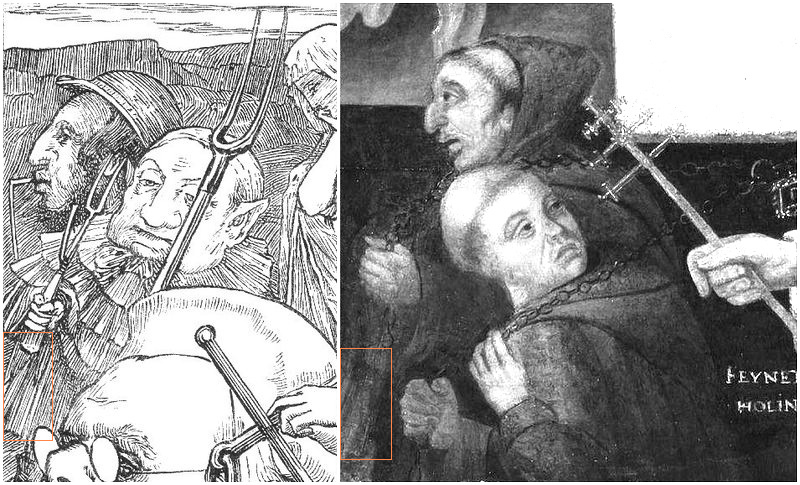
In this image one of the elements has been marked (orange frame) which Henry Holiday borrowed from a 17th century painting (by an anonymous artist). This might be a bit different from the borrowing described by T. S. Eliot in 1920. In the example shown here, the borrowing of the pictorial allusion is inconspicuous. It doesn’t enrich Holiday’s illustration. It’s only purpose might be that of a signpost pointing to another work of art.
more.
2017-09-27, update: 2019-02-25
Pigs and a Tuba
Help! I am seeing pigs!
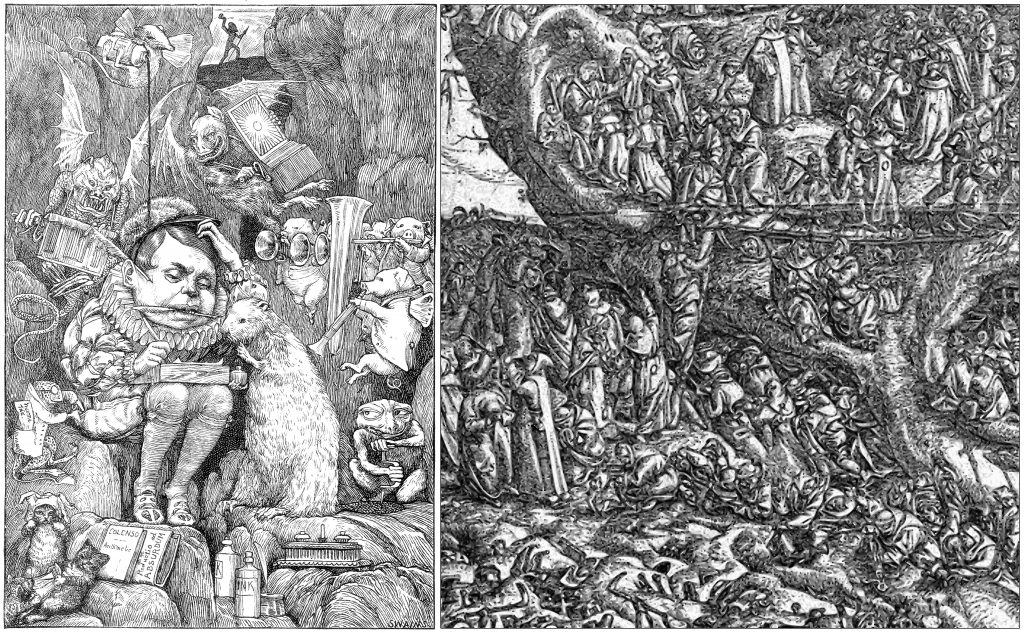
In some of his illustrations to Lewis Carroll’s The Hunting of the Snark, Henry Holiday alluded to The Image Breakers, a 16th century print made by Marcus Gheeraerts the Elder. I see at least one of Holiday’s pigs in that print (spoiler) and also something which Henry Holiday could have turned into a Moritz bass tuba.
2019 is the year of the pig. Does that make me see pigs everywhere, or did Henry Holiday see that pig in Gheeraert’s print too?
Actually, I have to confess that I saw the pig already in 2009. But I didn’t mark it then:
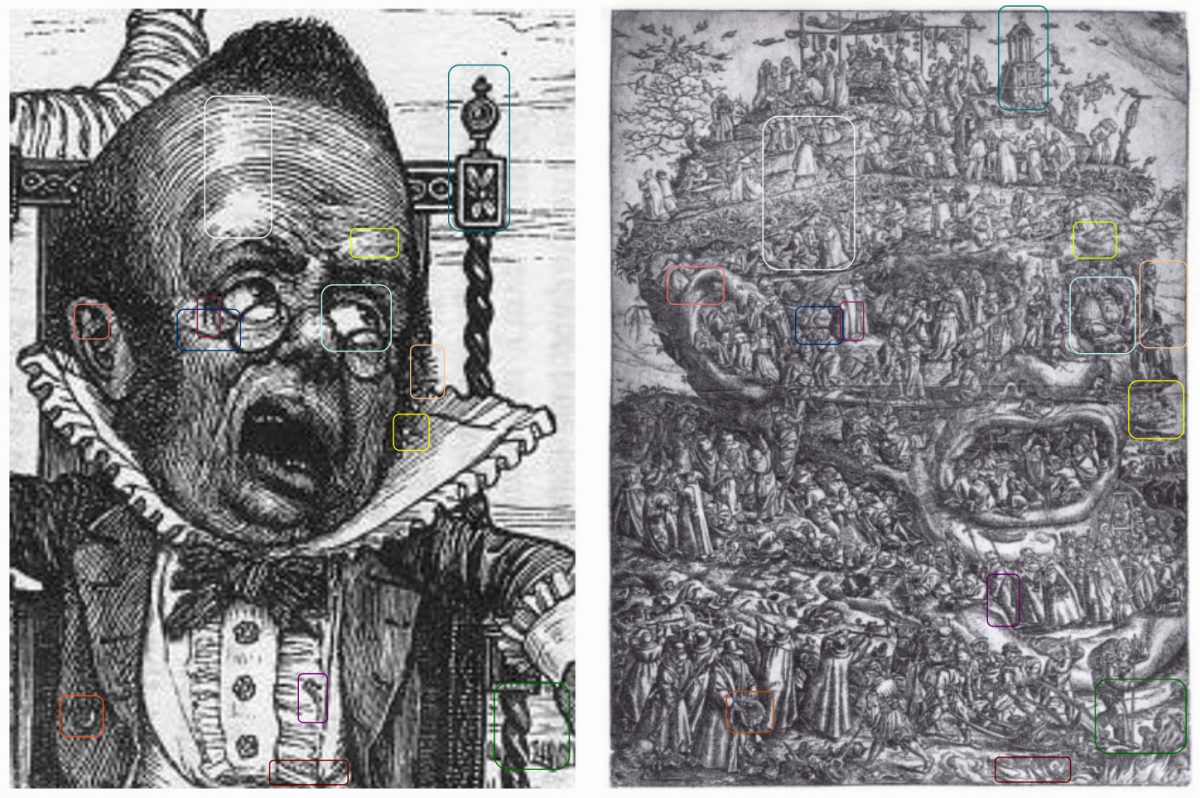
2019-02-14

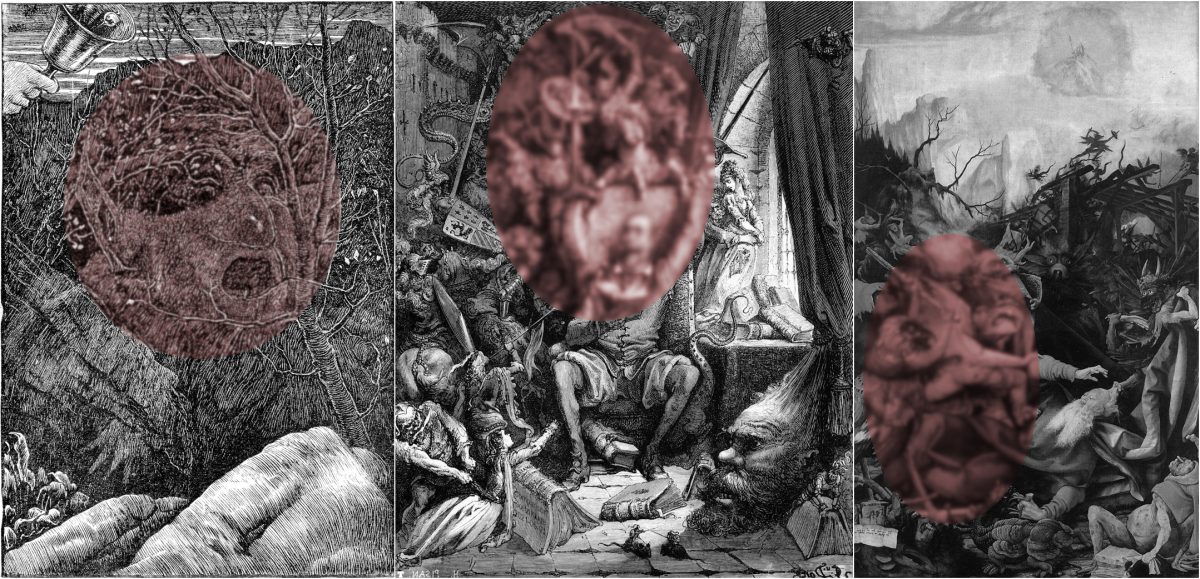
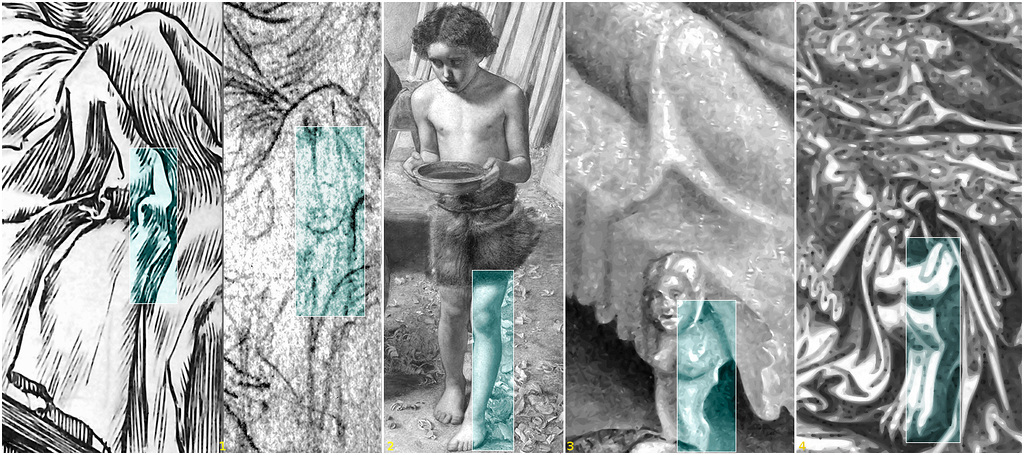
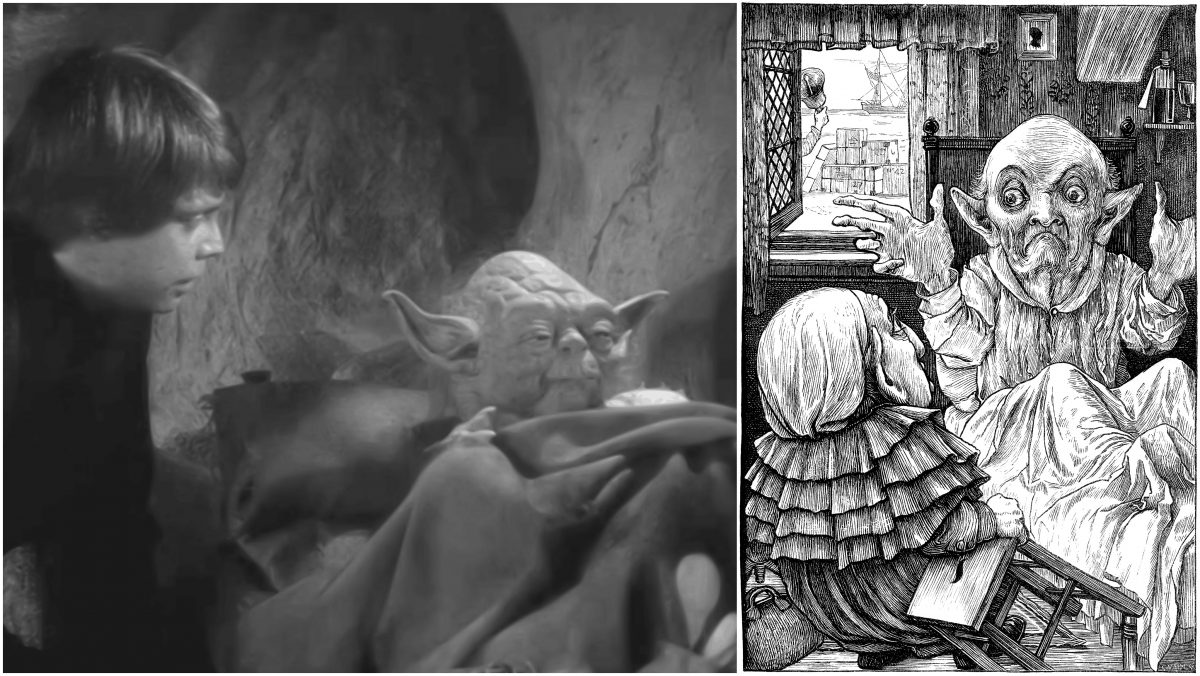
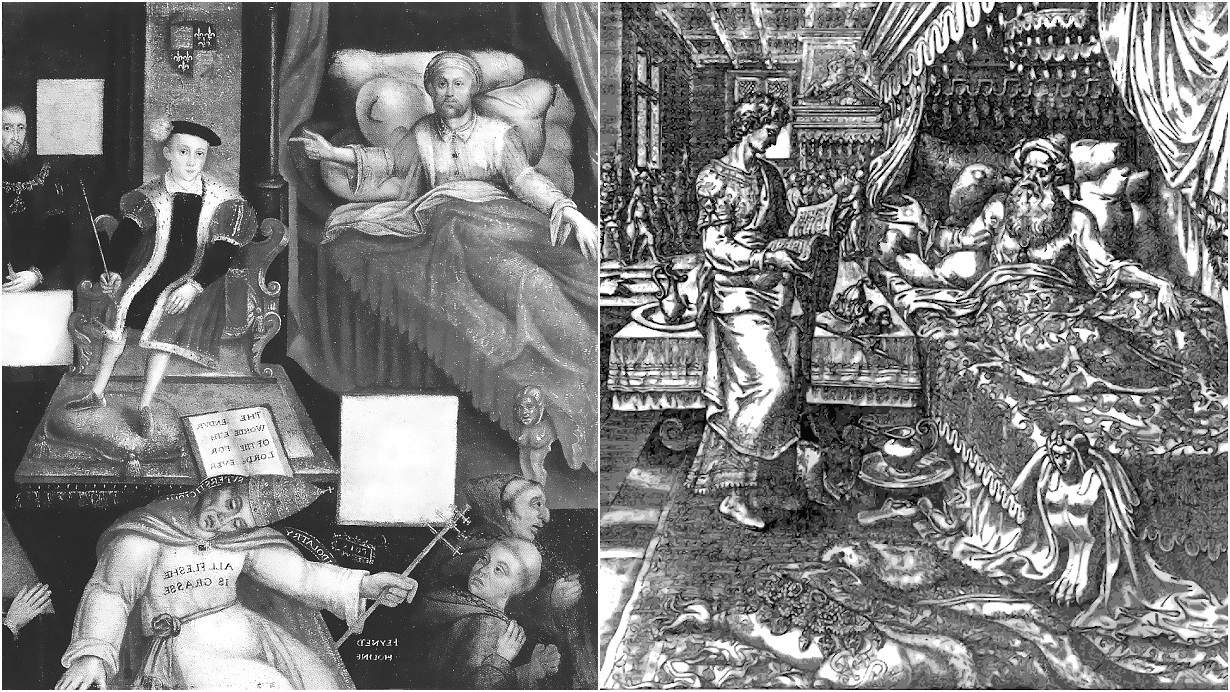
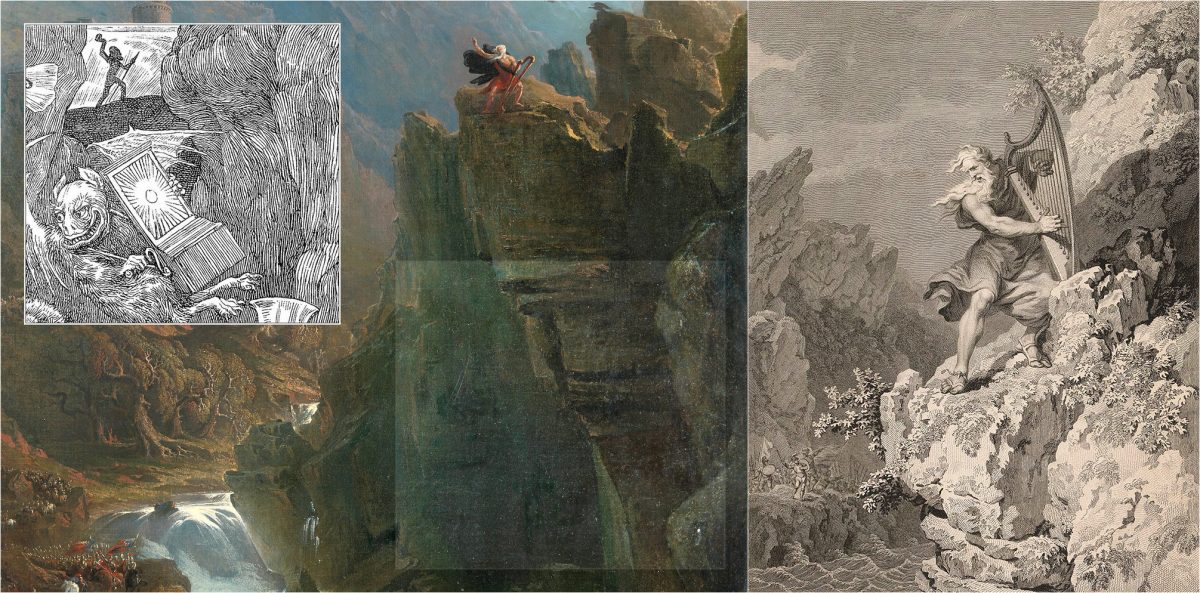

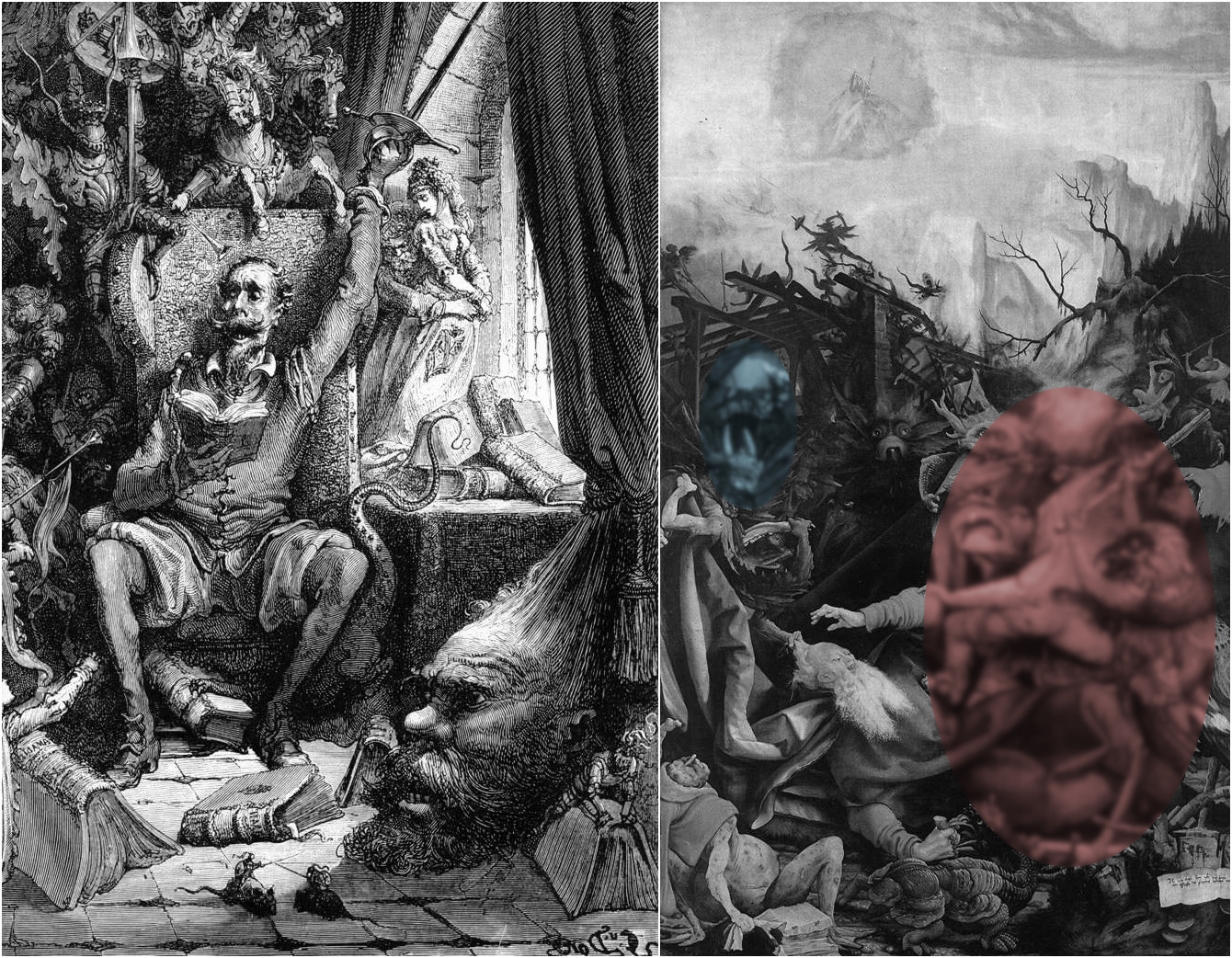
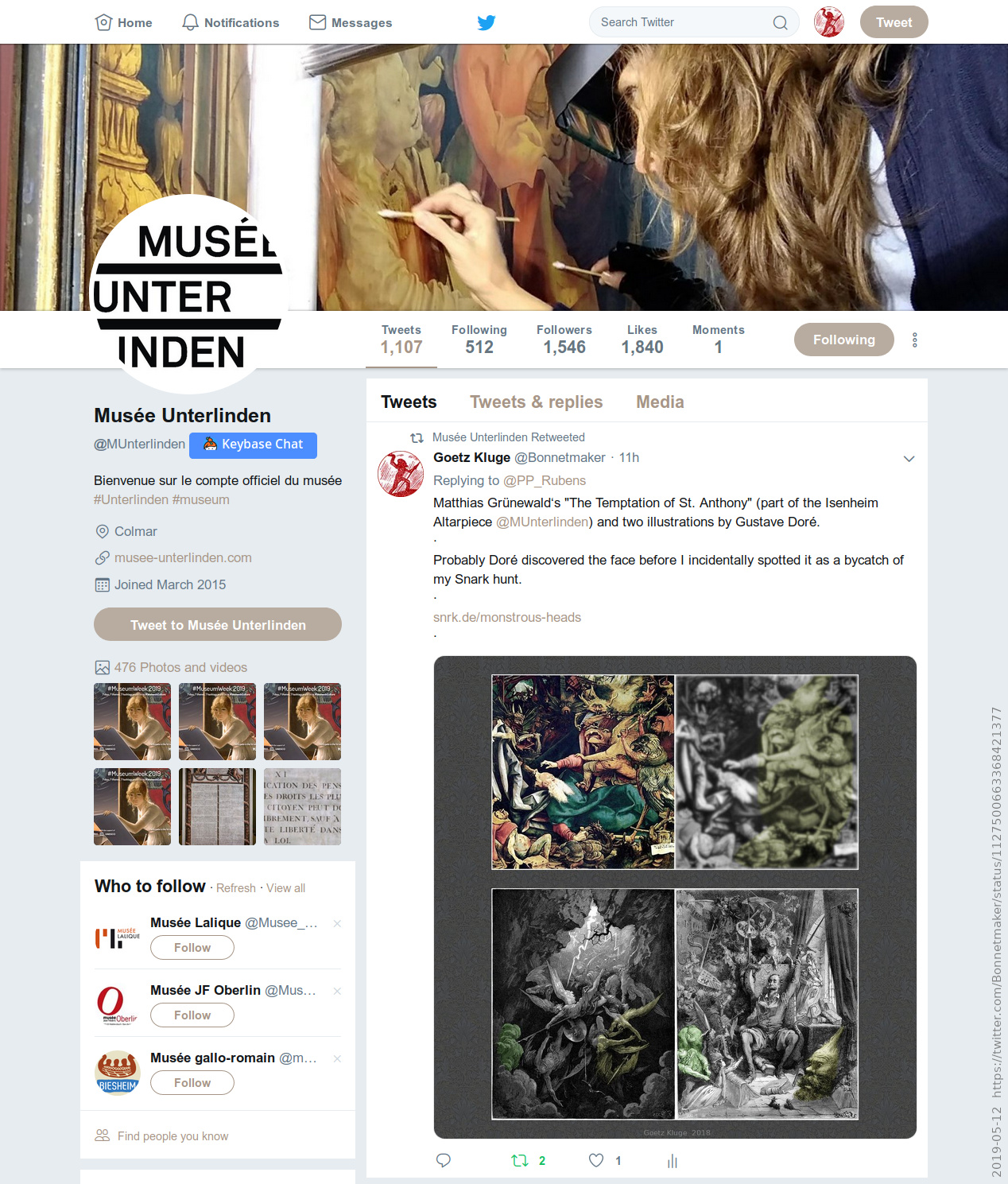
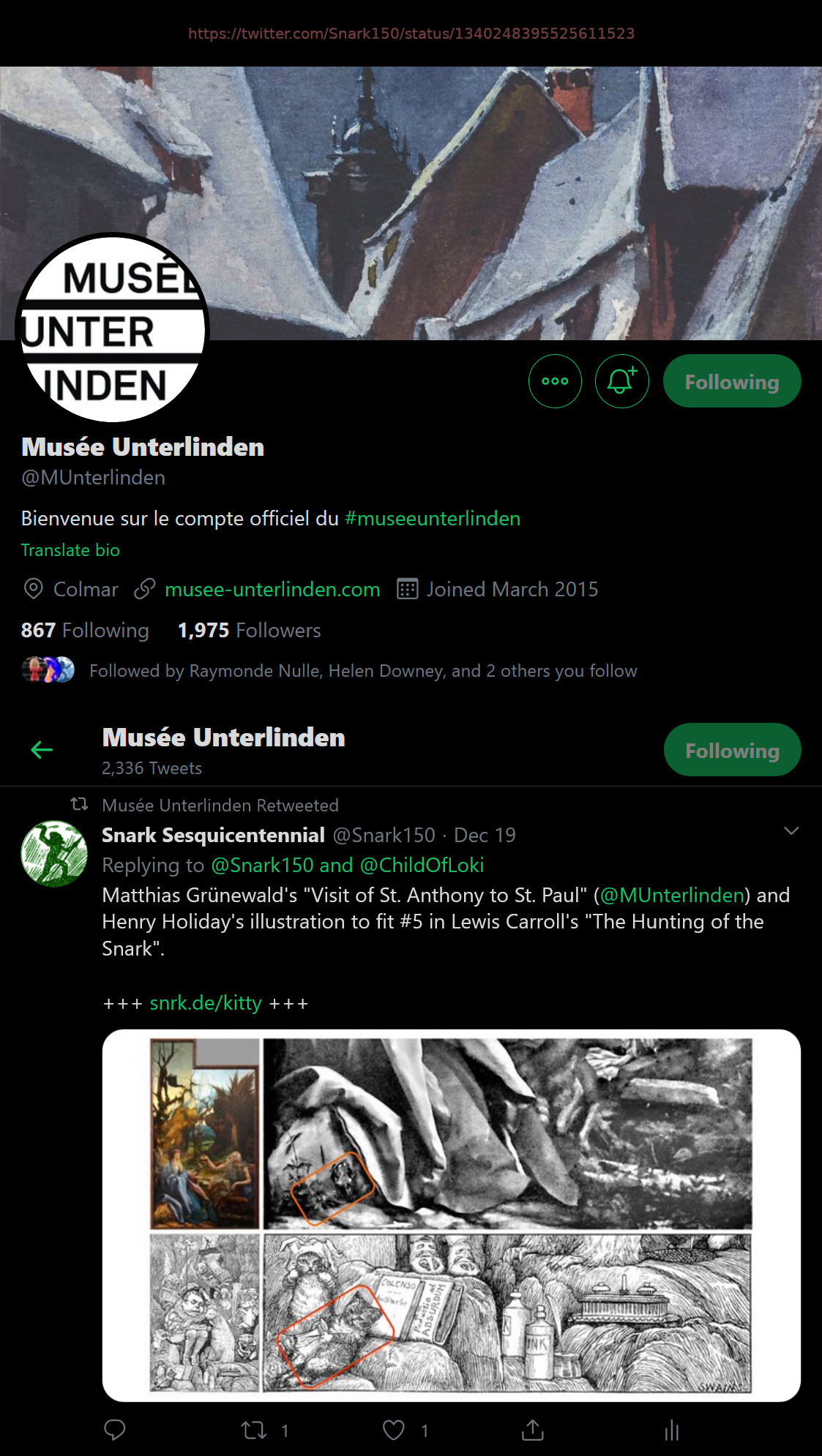
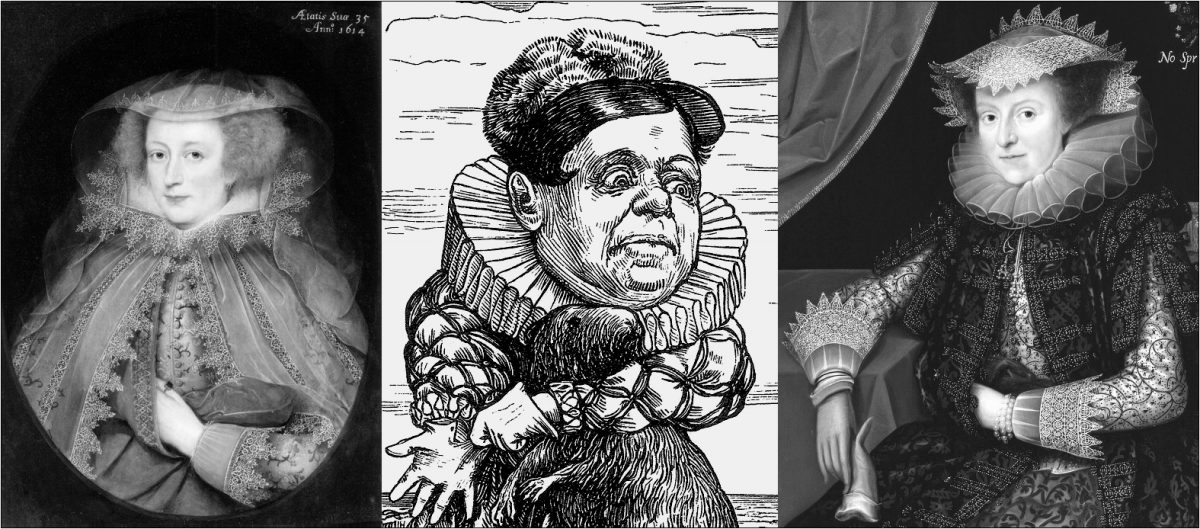
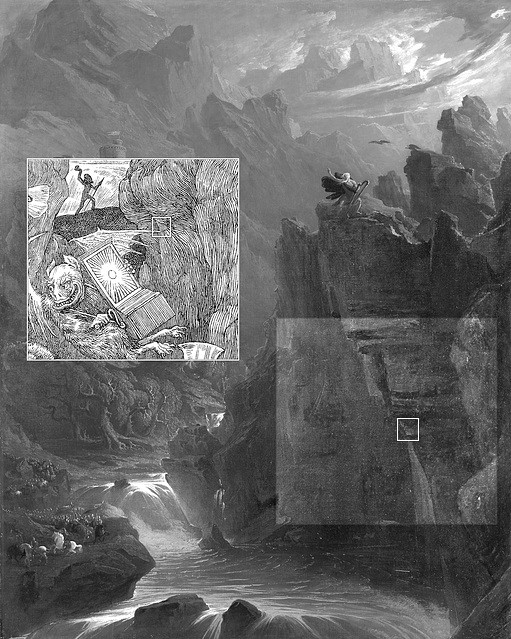
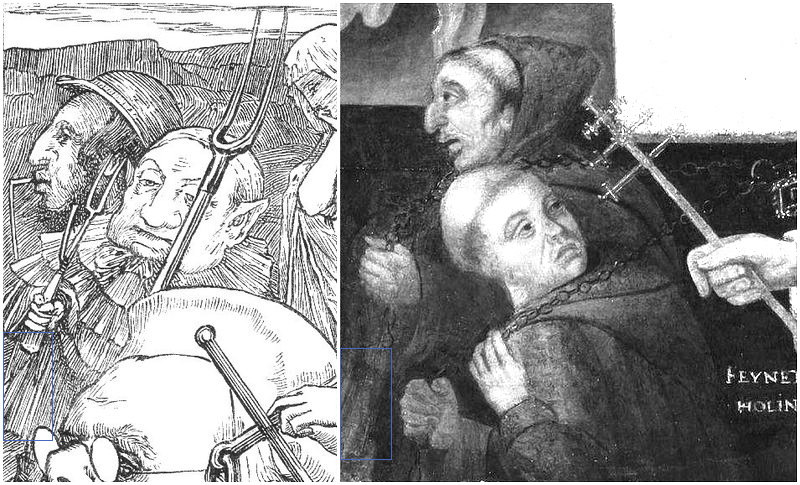
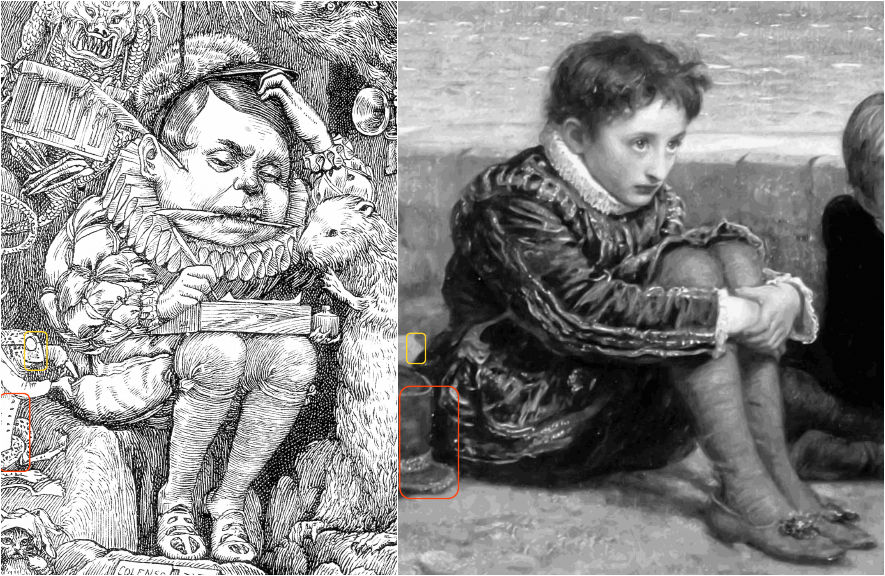
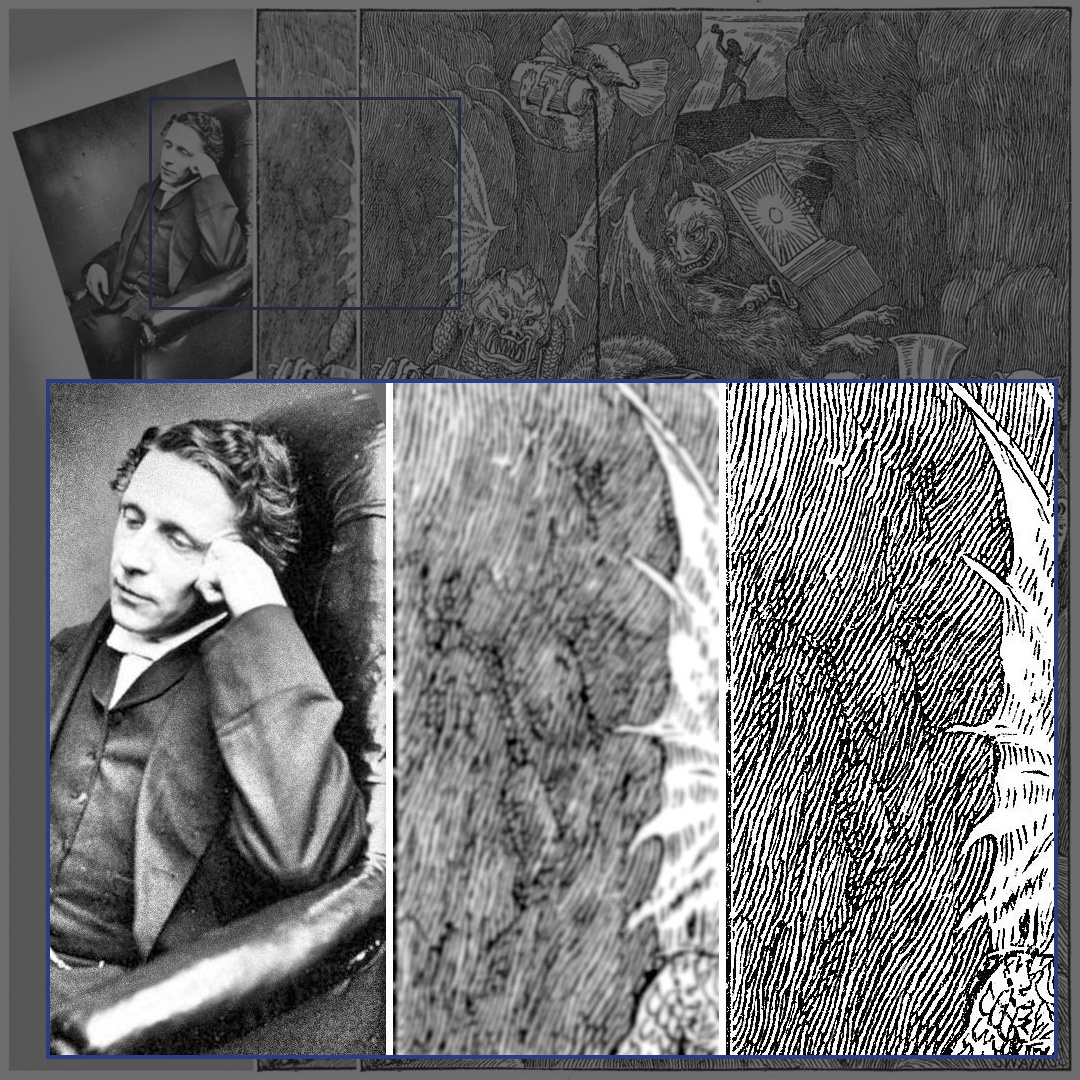
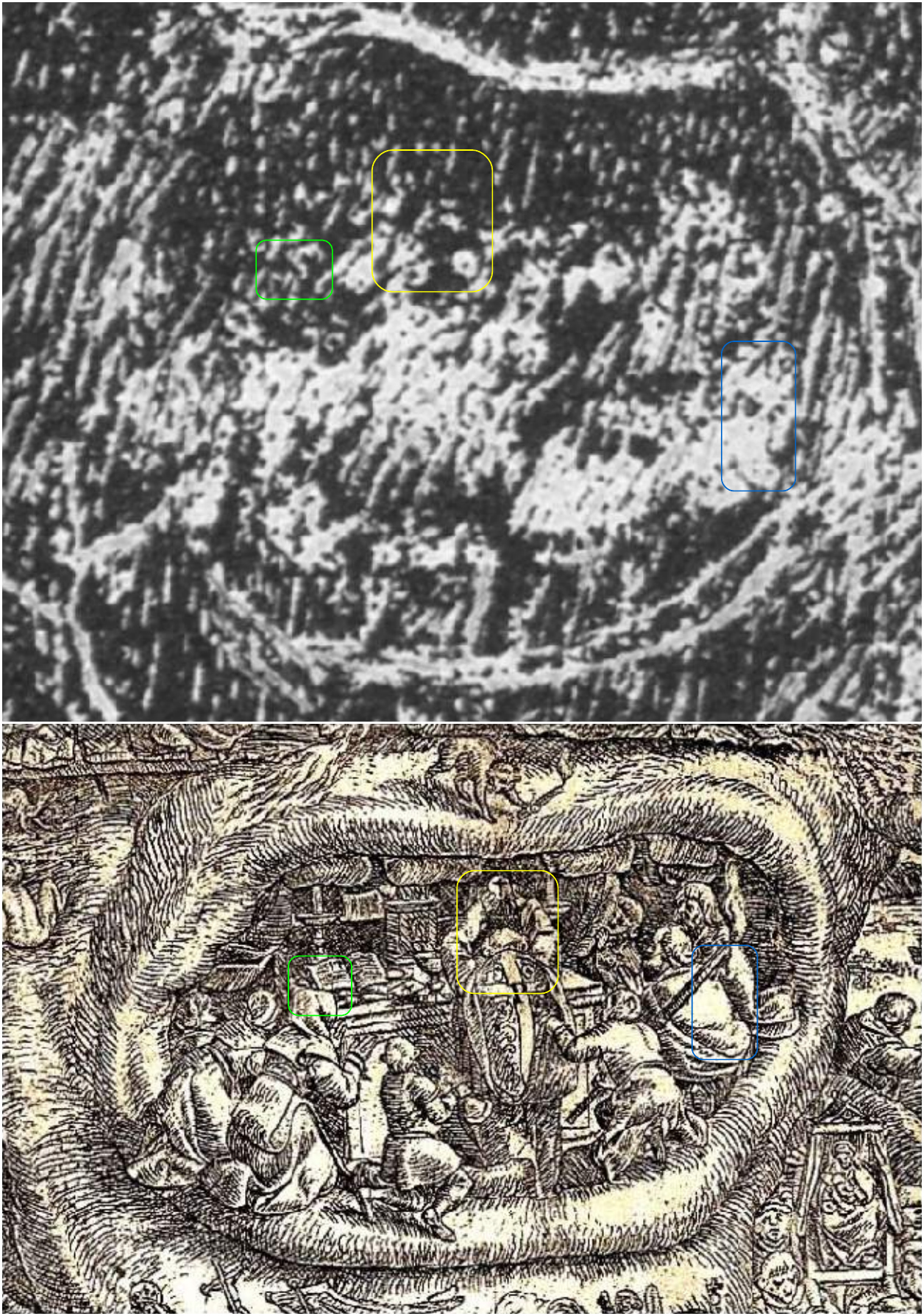
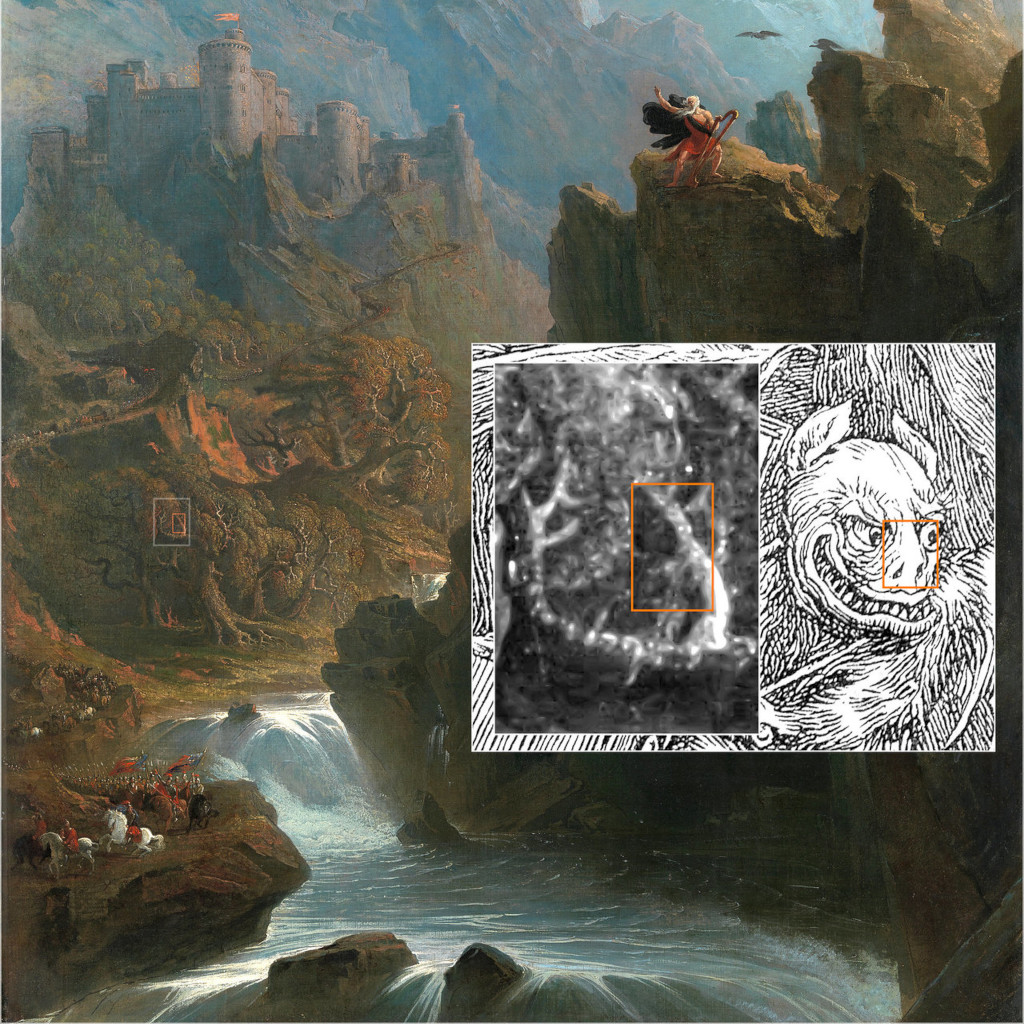
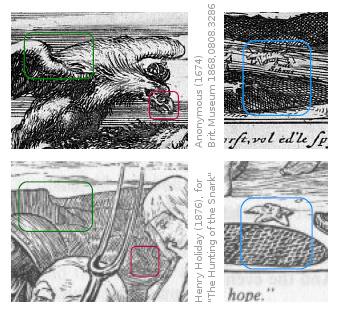
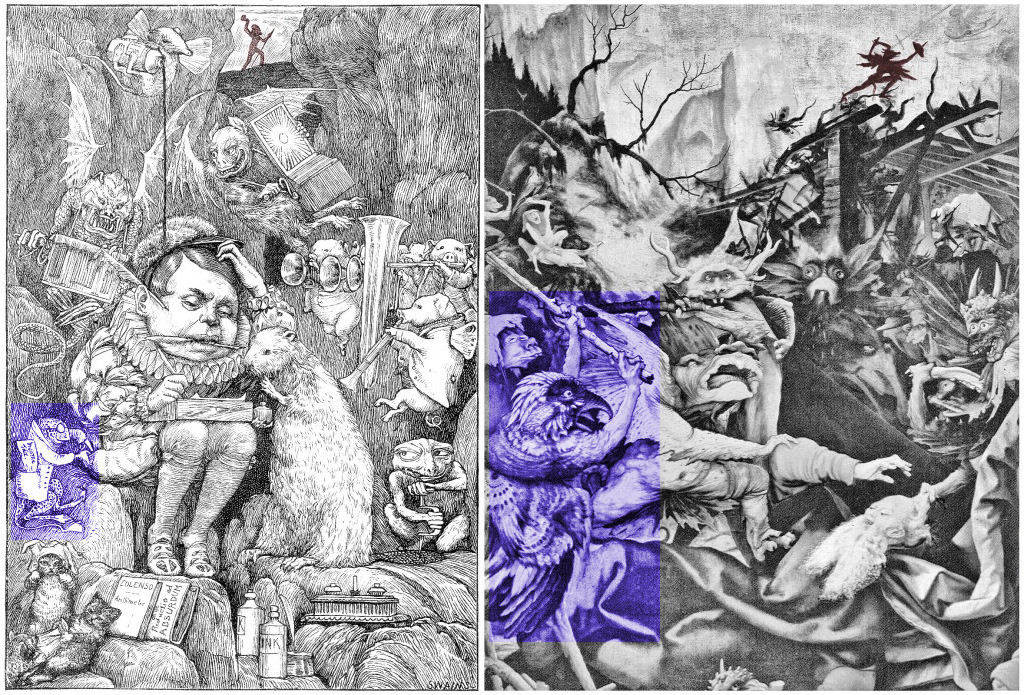

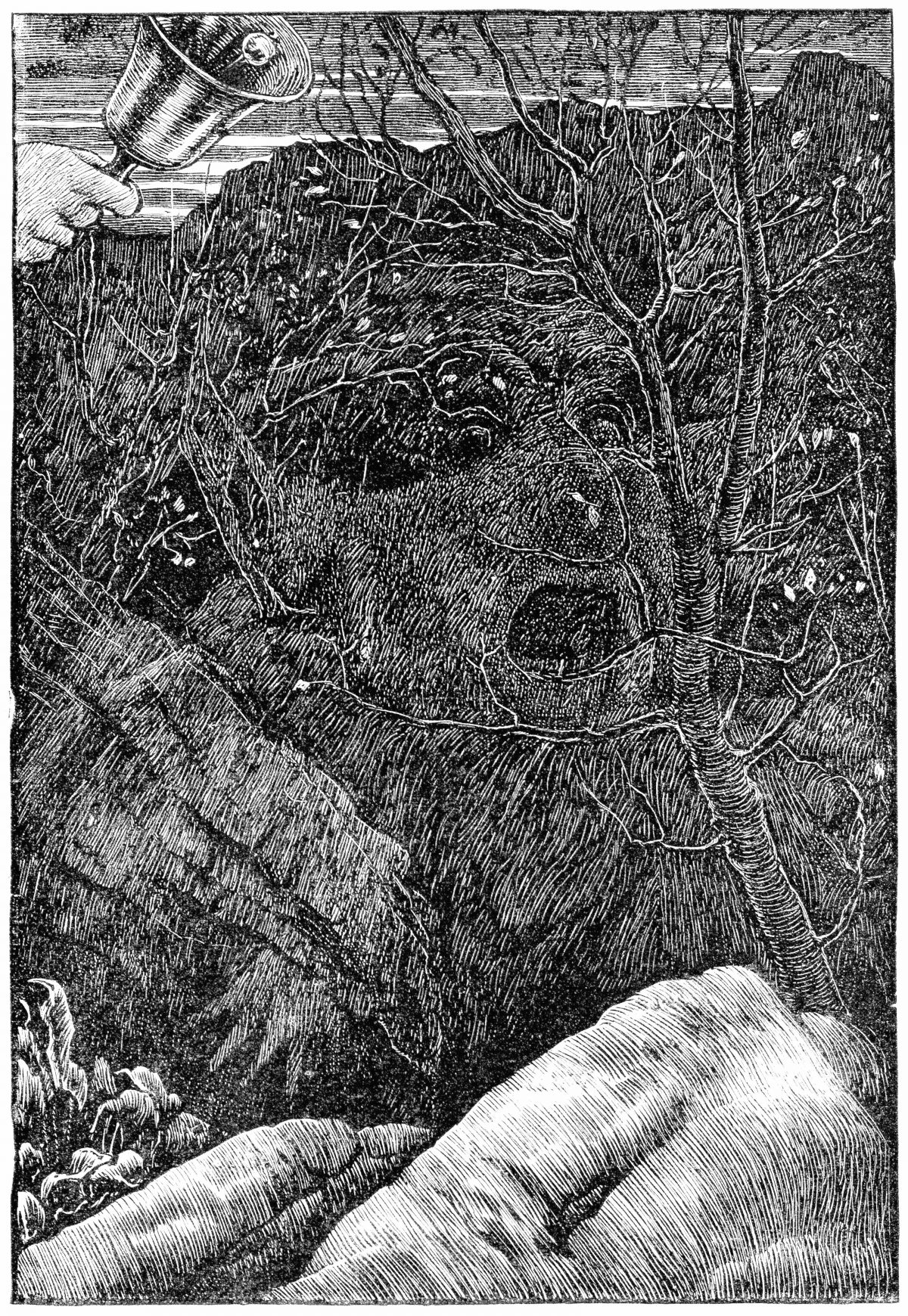 How well the academician Holiday succeeded in producing grotesques for the Snark (it is the only work of Carroll’s that he illustrated) is open to debate. Ruskin was certainly right in thinking him inferior to Tenniel. His drawings are, of course, thoroughly realistic except for the overzize heads and the slightly surrealist quality that derives less from the artist’s imagination than from the fact that he was illustrating a surrealist poem.
How well the academician Holiday succeeded in producing grotesques for the Snark (it is the only work of Carroll’s that he illustrated) is open to debate. Ruskin was certainly right in thinking him inferior to Tenniel. His drawings are, of course, thoroughly realistic except for the overzize heads and the slightly surrealist quality that derives less from the artist’s imagination than from the fact that he was illustrating a surrealist poem.